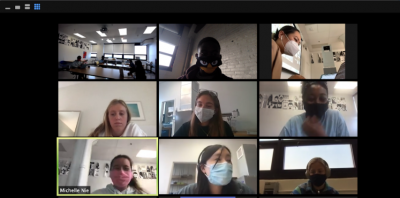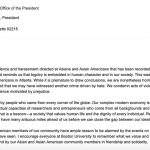A new campus environment calls for the creation of different roles to fill, and one new job available to students this semester aims to make the transition easier for the Boston University community.

Classroom moderators, as defined by BU Digital Learning and Innovation, are students helpers placed in classrooms to help the instructors facilitate smooth courses and engage the remote audience.
Julia Orioles, a senior in the Questrom School of Business, said she applied to be a classroom moderator this semester because she is interested in technology and wanted to gain more financial independence. The flexibility in work hours was also a factor, she added.
“It helps the people who are remote to still feel involved in class,” Orioles said, “so [they] can still participate and they’re not missing out on anything.”
During the application process, BU Information Services and Technology gave students two options on how to attend their interviews: sign up for a live Zoom call, or record a video response to a set of questions.
“I personally chose the video recording because it’s, in a way, easier,” Orioles said. “The video that you submit is just the best version of what you could say.”
Giovanni Dimaggio, a junior in the College of Arts and Sciences, said he applied for the position after having worked BU’s remote Orientation over the summer. That experience — in which he worked on Zoom for around 18 hours a week — gave him “a little bit of an upper hand” when it comes to the platform.
“I really thought that I was proficient at Zoom,” Dimaggio said, “and I could really use that experience to help out professors who were definitely in a new environment, completely out of their comfort zone.”
A total of 980 students applied to be classroom moderators, according to an email from IS&T sent through BU spokesperson Colin Riley. Of those who applied, 440 have been hired to date.
Hired moderators underwent training via remote meetings and instructional modules posted to Blackboard by IS&T. The modules, which Orioles said take several hours to complete and could be done any time before the start of the semester, contained an array of information ranging from how to address professors and students to identifying HDMI and USB cables.
BU IS&T began working on the modules as soon as it was informed of the classroom moderator initiative, the email stated, and completed them Aug. 17.
“Creating them required a team of people working first on an agenda and outline, then scripts and content, and then recording and making the content available on our technology platforms,” the team overseeing the moderators wrote. “We leveraged our IT staff most experienced in both classroom technology and working with student employees to generate the training.”
Now that classes have started, Orioles and Dimaggio are working around 10 hours a week, moderating multiple classes.
Hannah Burgess, a graduate student in the School of Public Health, is moderating a graduate course for students pursuing a Master of Science in Management Studies. She said the scheduling process looks more at a student’s availability than familiarity with course material.
Moderating different types of classes brings about unique challenges, Burgess said. When moderating a lecture, for example, she needs to be conscious of the flow of the class and find suitable times to ask the professor questions from the Zoom chat while not interrupting.
For discussion-based classes, she said the focus is more on ensuring multiple students are not speaking at once and helping to alert the professor of students who want to ask a question.
“Making sure that online students really feel like they’re a part of the discussion that’s going on inside of the classroom,” Burgess said, “that’s been probably the biggest struggle.”
Assistant professor Renato Mancuso, who is teaching a computer science course this semester, said having a moderator for his class is crucial.
“An effective hybrid model is hard with a moderator,” Mancuso said, “but it would be impossible without.”
Initially, Mancuso was not given a classroom moderator for either of his lecture periods due to him having two teaching fellows. However, time conflicts make it so his TFs are not always available to moderate in-person classes.
To be automatically eligible for a classroom moderator, IS&T criteria states the course must have more than 20 students, and that the professor cannot have a teaching assistant.
Mancuso said his course has about 110 students. While he said there was some confusion surrounding technology during his first class, he avoided the same issues once he acquired a moderator for one of his two lecture periods.
“She was extremely useful,” Mancuso said. “She had a good understanding … of what was the right setup for the audio in the class.”
With his moderator’s help, Mancuso said he was able to speed up the time it took to set up his laptop and the audio, as well as more effectively answer questions from the Zoom chat throughout the lecture. The moderator also helped remind Mancuso to repeat questions asked by those on Zoom, whom he can hear through his headphones but those in the classroom cannot.
David Shorten, a lecturer in the history department, wrote in an email that instructors and students are finding new ways to engage in their courses now that everyone is more than two weeks into the semester.
“In my experience so far, students are taking their studies especially seriously this semester,” Shorten wrote. “Key to the success so far has been the students’ and professors’ willingness to have open and honest communication about how they are faring and what challenges they are facing.”
Burgess said she believes the hardest part of being a moderator was getting past the first two weeks. Now that they have come and gone, she said she is optimistic about the rest of the semester.
“I think from now on, it’ll be learning from each other and being able to implement new things each class and make them a little different,” Burgess said, “I’m looking forward to that.”




